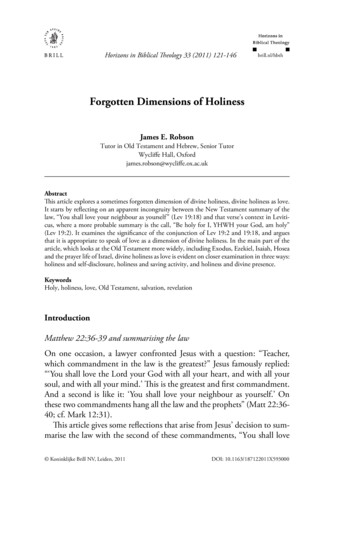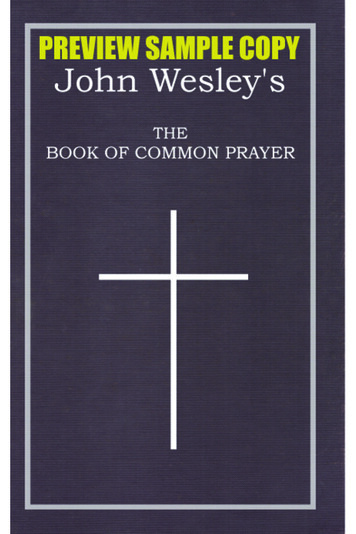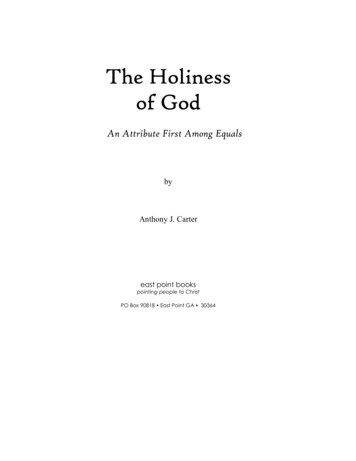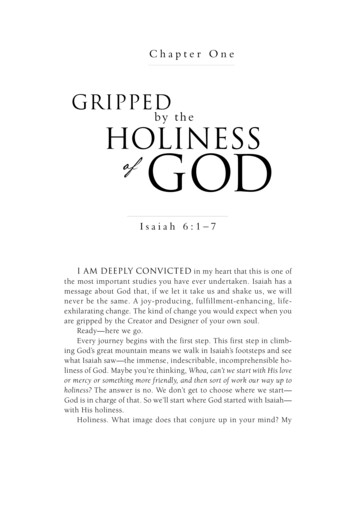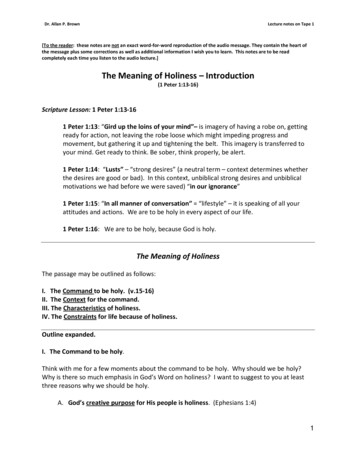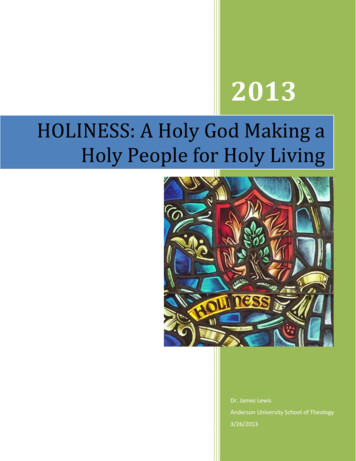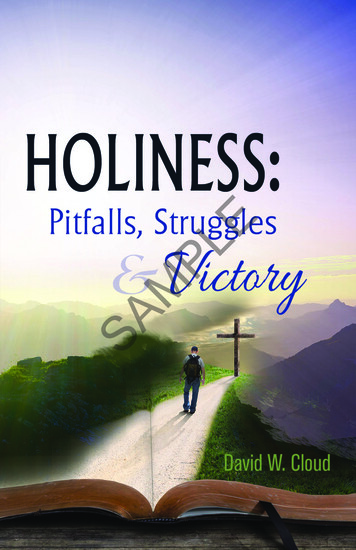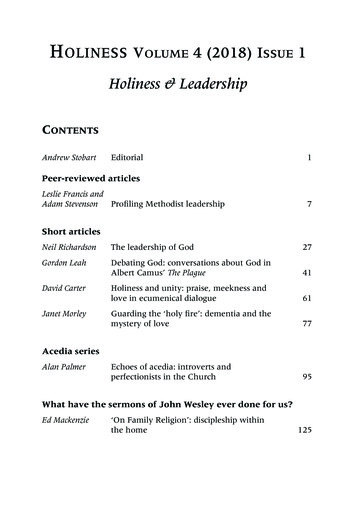
Transcription
HOLINESS VOLUME 4 (2018) ISSUE 1Holiness & LeadershipCONTENTSAndrew StobartEditorial1Peer-reviewed articlesLeslie Francis andAdam StevensonProfiling Methodist leadership7Short articlesNeil RichardsonThe leadership of God27Gordon LeahDebating God: conversations about God inAlbert Camus’ The Plague41Holiness and unity: praise, meekness andlove in ecumenical dialogue61Guarding the ‘holy fire’: dementia and themystery of love77Echoes of acedia: introverts andperfectionists in the Church95David CarterJanet MorleyAcedia seriesAlan PalmerWhat have the sermons of John Wesley ever done for us?Ed Mackenzie‘On Family Religion’: discipleship withinthe home125
DevotionalJane LeachHoly containment and the supervision ofleaders in ministryReview ArticleAndrew Stobart (ed) ‘Storying the leading’: curating narratives ofleadership in conversation with Vaughan S.Roberts and David Sims, Leading by Story:Rethinking Church Leadership141149ReviewsBrian E. Beck, Methodist Heritage and Identity167David Dickinson, Yet Alive: Methodists in British Fiction Since 1890169Steven Emery-Wright and Ed Mackenzie. Networks for FaithFormation: Relational Bonds and the Spiritual Growth of Youth171Michael Green, Radical Leadership: In the New Testament and Today173Dalai Lama, Desmond Tutu, Douglas Abrams, The Book of Joy:Lasting Happiness in a Changing World175Gordon Leah, There Your Heart Will Be177Philip J. Richter, Spirituality in Photography: Taking Pictureswith Deeper Vision179John Sutherland, Blue: A Memoir – Keeping the Peace and Fallingto Pieces181Rowan Williams, Being Disciples: Essentials of the Christian Life183
HOLINESSTHE JOURNAL OF WESLEY HOUSE CAMBRIDGEEditorialAndrew StobartILeadership, like holiness, eludes straightforward definition. There are a coupleof reasons why this observation rings true. First, and perhaps most crucially,there is no such thing as ‘raw leadership’, which exists in a contextual vacuum.Just as holiness is the holiness of God, or the Church, or Scripture, or theology,so leadership is the leadership of a community, an organisation, a church, agroup, a family, or a nation. Leadership is therefore a derivative concept, ratherthan an originating one, as much shaped by the culture in which it isrecognised, authorised and offered, as it gives shape to that culture. It may wellbe a necessary tautology to be reminded that leadership without follower-shipis not in fact leadership, no matter how much we might wish otherwise.a second reason for the elusiveness of definition is that leadership, again likeholiness, is much easier to describe in relief. Good leadership is appropriatelycelebrated as the success of the company of people that is being thus well led.On the contrary, failure of whatever kind is more often attributed to specificleadership deficiencies: the leader was too controlling or not in control, tootentative or too bold, too imaginative or not imaginative enough, tooambitious or too cautious, and on and on through as many binaries as you canname. In the words of one recent study, reviewed later in this issue, leadershipis often thought of as the ‘panacea’ for the issues that befuddle society andorganisations today.1 If only we could ‘get the right leaders’, then all would bewell. We recognise leadership in its absence, or in its failure, more clearly andreadily than when it is working.www.wesley.cam.ac.uk/holinessHOLINESS The Journal of Wesley House CambridgeVolume 4 (2018) Issue 1 (Holiness & Leadership): pp. 1–5ISSN 2058-5969Copyright author
Andrew StobartThe connections between leadership and holiness, however, are not merelyconjunctive. as well as sharing the difficulty of definition, the two conceptshave a more intrinsic link, which can be revealed by digging into the Wesleyantradition.In his ‘Rules for a Helper’, John Wesley instructs the early Methodist leaders,‘Make “Holiness unto the Lord” your motto.’2 Wearing this badge, earlyMethodist leaders were to attend carefully to themselves and their societies sothat the outcome of their energies would be to ‘build them up in that holinesswithout which they cannot see the Lord’. Holiness, it might be said, is thepurpose of leadership. at their best, all the various instruments of leadershipwithin the Wesleyan tradition are best understood as mechanisms forconvening and nurturing a society of holiness, which can be presented to Godand to the world as the fragrant presence of Christ.3Leadership, in the best Wesleyan tradition, is only ever for the sake of holiness;or better, for the sake of the holy God who intends his community to inhabitand enjoy his holy, wholesome, perfect life. If, as Calvin Samuel notes in hisrecent monograph on holiness, this suggests that we hold out ‘a selfconsciously utopian vision of the world’,4 then we are merely locatingleadership on an eschatological stage, and are standing in the good companyof the prophets and the apostles before us. In so far as that holy vision remainsover the horizon of the future, leadership offered today will be provisional andhopeful, humble and yet confident in its dependence upon God. as we havesaid, leadership, like holiness, eludes straightforward definition.IIThe contents of this issue of Holiness, arranged around the theme of leadership,provide resources for further reflection on the role that leaders play – the placethat they occupy – in the journey of God’s people from here and now, to the‘there and then’ of creation’s divine denouement. These articles, reflections andreviews warrant careful reading and discussion, keeping the followingquestions in mind. Do I recognise the leadership described here? How mightthis subject matter challenge my view of who leads, and why they lead? Whatare the challenges for the leadership that I seek to offer? Who and what isshaping my view of leadership? Should these articles prompt such a discussion,then the labours of their authors, and of this journal, will have been worthwhile.2
EditorialFor instance, how might the findings of Leslie Francis and adam Stevenson, intheir research into the psychological type and temperament profiles of BritishMethodist preachers and ministers, affect the way that you view the respectiveofferings in worship week by week? In so far as leadership of worship in BritishMethodism is so often shared between lay and ordained, how might therespective gifts offered by each be celebrated and combined to help the Churchnavigate its onward journey in faithfulness? The next instalment of alan Palmer’sseries on acedia contributes to this conversation, particularly with regard tointroverts in the Church, who have often felt compelled to mimic a moreextroverted ministerial model. Understanding the healthy contributions thatboth introverts and perfectionists can make to leadership enables us to recogniseand moderate the less healthy aspects of introversion and perfectionism.Neil Richardson’s article opens up the often-overlooked idiom of the ‘leadershipof God’, grappling with the difficult theological themes of suffering andjudgement, concluding strikingly that ‘God leads from the cross’ (p. 38). Offeringleadership in the context of extreme pain and loss is explored again in GordonLeah’s examination of the conversations about God in albert Camus’ novel, ThePlague. In a quite different way, Janet Morley’s personal reflections in her articleprompt us to consider the role of leaders in ‘guarding the “holy fire”’ of spirituallife through the experience of dementia. a painting and reflection by JaneLeach, Containment, speaks to this involved and involving leadership task,asking readers to consider how they are holding others – and being heldthemselves – through their leadership.‘Holiness and Christian unity belong together as twin aspects of the samerelationship with the Trinity such that the pursuit of either involves the pursuitof the other.’5 These words from the Methodist–Roman Catholic dialoguereport, The Call to Holiness, stand at the beginning of David Carter’s article‘Holiness and unity’, describing an ambitious agenda for church leadershiptoday as we seek to move beyond the schisms of the past. Ed Mackenzie’sarticle acknowledges that the ‘habitat of holiness’ is not only the Church, butalso the home, where parents in particular have a crucial role in offeringappropriate and compelling leadership in discipleship to their children.Ed Mackenzie’s recent book, Networks for Faith Formation, co-authored withSteven Emery-Wright, is one of nine works considered in the Reviews section.From photography to policing, and Methodists in fiction to Methodists inhistory, the books reviewed here offer helpful pointers for your next readingafter Holiness.3
Andrew Stobarta further recent publication, Leading by Story by Vaughan Roberts and DavidSims, stands out as a particularly significant contribution to the theme of thisissue. as a result, staff and students of Wesley House made it the subject of arecorded conversation in January 2018. Written up here, ‘Storying the leading’explores the central themes of Roberts’ and Sims’ book, applying them in across-cultural setting. Whatever else you read of this issue, this long reviewarticle is deserving of attention, since it offers a significant (and potentiallytransformative) heuristic tool to the task of leadership today: ‘“Storying theleading” is essential for all leadership today, if the Church is to be self-aware,globally conversant, and open to the many gifts that God gives through others’(p. 164).IIIas with the previous issue of Holiness, we are indebted to the trust fund namedby and for John Newton Davies and Sarah Davies, which is currently helpingto finance this open-access journal.6 at a time of transition and growth forWesley House, recalling the life and witness of those who have trained to beleaders of God’s people in this place is a crucial leadership task for ourselves,as we navigate today’s challenges and opportunities. It is a task we fulfil withgratitude and seriousness, not least in our daily prayers as a community.You, the readers of this journal, are, by extension, part of the Wesley Housecommunity: a global community in the Wesleyan tradition of scholarship andprayer. as editor, I recognise the hiatus in the appearance of this issue, due inno small part to my own move to be part of Wesley House’s residentialcommunity as Director of Research. Joining the community in a new way, I havebegun to see in higher definition how the founding aims of this House haveshaped a story to which I, and you, now belong. as Roberts and Sims note intheir book, at times a story can itself be the leader.7 Caught up in this story ofscholarship and spirituality, faith and formation, research and renewal, Holinessis committed to offering the critical space for global, practical, informedreflection, so that the narrative of Wesleyan tradition may continue and flourish.andrew Stobart, Commissioning EditorOctober 20184
EditorialNotes1.2.3.4.5.6.7.Vaughan S. Roberts and David Sims, Leading by Story: Rethinking ChurchLeadership, London: SCM Press, 2017, p. 3.‘The Twelve Rules of a Helper’, 1753, in Constitutional Practice and Disciplineof the Methodist Church: Volume 1, London: Methodist Publishing House, 1988,pp. 77–78.‘But thanks be to God, who in Christ always leads us in triumphal procession,and through us spreads in every place the fragrance that comes from knowinghim’ (2 Corinthians 2:14).Calvin Samuel, MORE Distinct: Reclaiming holiness for the world today, London:IVP, 2018, p. 119.‘The Call to Holiness’, para 5. The full text can be found online: 16.pdf.For further information on John and Sarah Davies, see Holiness 3(2) (2017),‘Holiness & Reformation’, pp. 156–159.Roberts and Sims, Leading by Story, p. 49.5
HOLINESSTHE JOURNAL OF WESLEY HOUSE CAMBRIDGEProfiling Methodist leadershipLeslie Francis and Adam StevensonTHE REVD CANON PROFESSOR LESLIE J. FRANCIS is Director of the Warwick Religions andEducation Research Unit, University of Warwick, and Honorary DistinguishedCanon, Manchester Cathedral.leslie.francis@warwick.ac.ukWarwick, UKTHE REVD ADAM J. STEVENSON is a Presbyter in The Fens circuit and part of theWarwick Religions and Education Research Unit, University of Warwick, workingon his PhD, 'An ordinary theology of Methodist worship'.adam.stevenson@methodist.org.ukWisbech, UKThis paper explores the similarities and dissimilarities between the psychologicaltype and temperament profiles of Methodist local preachers and Methodistcircuit ministers in the British Methodist Church. New data provided by 80male and 62 female local preachers who completed the Francis PsychologicalType Scales were compared with the profiles of 693 male and 311 femaleministers published in 2010. The most important significant difference betweenthe two groups concerns the higher proportions of the Epimethean Temperament(SJ) among both the male (69% compared with 44%) and female (66%compared with 43%) local preachers. The SJ temperament brings a moreconservative and conserving approach to ministry.PSYCHOLOGICAL TYPE THEORY KEIRSEY TEMPERAMENT THEORY CLERGYSTUDIES METHODIST LOCAL PREACHERSwww.wesley.cam.ac.uk/holinessHOLINESS The Journal of Wesley House CambridgeVolume 4 (2018) Issue 1 (Holiness & Leadership): pp. 7–26ISSN 2058-5969Copyright Author
Leslie Francis and Adam StevensonIntroductionMethodist circuit ministry in Great Britain today is maintained by the combinedefforts of Methodist circuit ministers ordained to presbyteral ministry and oflocal preachers serving in the circuit (see British Methodism Today by Haleyand Francis 2006). Without local preachers, circuit ministry would not besustainable.Lay preachers have been a feature of Methodism since its conception. MargaretBatty recounts stories of two early lay preachers, Thomas Westall and ThomasMaxfield, who were permitted to preach by the Wesleys, even though they hadreservations about the added difficulties such ‘irregularities’ may cause theirrelationship with the Church of England (Milburn and Batty 1995). AsMethodism developed, so did the number of lay preachers. In the minutes ofmeetings held from 1751 onwards it became evident that lay preachers werevery much part of Methodism. Then, in 1797, Conference established the LocalPreachers’ Meeting and a mechanism for checking on the standards ofpreaching by involving both the superintendent minister and the wider bodyof local preachers.The role of local preachers continued to develop, and their status and identity inthe various branches of nineteenth-century Methodism was not a consistentpicture. After Methodist Union in 1932 local preachers were mainly trainedthrough the study of set textbooks with written examinations administered bythe Methodist Church. In 1990 a new training course was launched using localtutors and containing units of study. This 1990 course was only superseded in2017 by the latest training course that is modular and uses web-based learning.The Local Preachers’ Meeting still conducts oral examinations for preachers, atthe various stages of development, allowing preachers in training to account fortheir calling, development and assent to Methodist doctrine. Local preachers arefirst given a ‘note’ to preach, and during this initial stage they test their calling tothis ministry, as does the local Methodist circuit. At the same time, they beginthe formal training course on which they are supported by a local tutor andmentor. Local preachers move to being ‘on trial’ until their training is completedsatisfactorily and they are ‘fully accredited’. Today there are 6,602 fully accreditedlocal preachers, with a further 655 on note and 896 on trial (Methodist Church2017). Each person is likely to be leading between four and six acts of worship ina quarter according to the Millennial Profile (Sawkins 2002). An individual church,however, could expect half or even three-quarters of its services to be led by localpreachers, depending on the ordained resources of the circuit.8
Profiling Methodist leadershipAgainst this background, the aim of the present study is to report a newempirical survey of the psychological type and temperament profile of localpreachers and to set that alongside the profile of Methodist circuit ministerspublished by Burton, Francis and Robbins (2010). The purpose of the comparison is to test whether local preachers and Methodist circuit ministers bringthe same or different psychological preferences and gifts to their leadership ofworship and to the life of the local chapel. But first it is necessary to give somebroader context to psychological type theory and to temperament theory.Psychological type theoryPsychological type theory has its roots in the observations and documentationof human behaviour by Jung (1971) and in the developments shaped by theMyers-Briggs Type Indicator (Myers and McCaulley 1985), the KeirseyTemperament Sorter (Keirsey and Bates 1978) and the Francis PsychologicalType Scales (Francis 2005). The basic building blocks of psychological typetheory distinguish between two orientations (extraversion and introversion),two perceiving functions (sensing and intuition), two judging functions(thinking and feeling), and two attitudes towards the outer world (judging andperceiving). Francis and Payne (2002) speculated about the implication of thesebuilding blocks of psychological type theory for ways in which clergy mayprefer to shape and focus their ministry style.The two orientations are concerned with where energy is drawn from: energycan be gathered either from the outside world or from the inner world. Clergywho prefer extraversion (E) are orientated towards the outside world; they areenergised by the events and people around them. They enjoy communicatingand thrive in stimulating and exciting environments. They prefer to act in asituation rather than to reflect on it. They may vocalise a problem or an idea,rather than thinking it through privately. They tend to focus their attentionupon what is happening outside themselves. They are usually open individuals,easy to get to know, and enjoy having many people around them. In contrast,clergy who prefer introversion (I) are orientated towards their inner world; theyare energised by their inner ideas and concepts. They may feel drained byevents and people around them. They prefer to reflect on a situation ratherthan to act in it. They enjoy solitude, silence and contemplation, as they tendto focus their attention upon what is happening in their inner life. They mayappear reserved and detached as they are difficult to get to know.9
Leslie Francis and Adam StevensonThe perceiving functions are concerned with the way in which people receiveand process information; this can be done through use of the senses or throughuse of intuition. Clergy who prefer sensing (S) focus on the realities of asituation as perceived by the senses. They tend to focus on specific details,rather than the overall picture. They are concerned with the actual, the real andthe practical, and tend to be down-to-earth and matter-of-fact. They may feelthat particular details are more significant than general patterns. They arefrequently fond of the traditional and conventional. They may be conservativeand tend to prefer what is known and well established. In contrast, clergy whoprefer intuition (N) focus on the possibilities of a situation, perceiving meaningsand relationships. They may feel that perception by the senses is not as valuableas information gained from the unconscious mind; indirect associations andconcepts impact their perceptions. They focus on the overall picture, ratherthan specific facts and data. They follow their inspirations enthusiastically, butnot always realistically. They can appear to be up in the air and may be seen asidealistic dreamers. They often aspire to bring innovative change to establishedconventions.The judging functions are concerned with the way in which people makedecisions and judgements; this can be done through use of objectiveimpersonal logic or subjective interpersonal values. Clergy who prefer thinking(T) make judgements based on objective, impersonal logic. They value integrityand justice. They are known for their truthfulness and for their desire forfairness. They consider conforming to principles to be of more importance thancultivating harmony. They are often good at making difficult decisions as theyare able to analyse problems in order to reach an unbiased and reasonablesolution. They are frequently referred to as ‘tough-minded’. They may considerit to be more important to be honest and correct than to be tactful, whenworking with others. In contrast, clergy who prefer feeling (F) make judgementsbased on subjective, personal values. They value compassion and mercy. Theyare known for their tactfulness and for their desire for peace. They are moreconcerned to promote harmony than to adhere to abstract principles. Theymay be thought of as ‘people persons’, as they are able to take into accountother people’s feelings and values in decision-making and problem-solving,ensuring they reach a solution that satisfies everyone. They are often thoughtof as ‘warm-hearted’. They may find it difficult to criticise others, even when itis necessary. They find it easy to empathise with other people and tend to betrusting and encouraging of others.10
Profiling Methodist leadershipThe attitudes towards the outside world are concerned with the way in whichpeople respond to the world around them, either by imposing structure andorder on that world or remaining open and adaptable to the world aroundthem. Clergy who prefer judging (J) have a planned, orderly approach to life.They enjoy routine and established patterns. They prefer to follow schedulesin order to reach an established goal and may make use of lists, timetables ordiaries. They tend to be punctual, organised and tidy. They may find it difficultto deal with unexpected disruptions of their plans. Likewise, they are inclinedto be resistant to changes to established methods. They prefer to makedecisions quickly and to stick to their conclusions once made. In contrast, clergywho prefer perceiving (P) have a flexible, open-ended approach to life. Theyenjoy change and spontaneity. They prefer to leave projects open in order toadapt and improve them. They may find plans and schedules restrictive andtend to be easy-going about issues such as punctuality, deadlines and tidiness.Indeed, they may consider last-minute pressure to be a necessary motivationin order to complete projects. They are often good at dealing with theunexpected. Indeed, they may welcome change and variety as routine boresthem. Their behaviour may often seem impulsive and unplanned.Temperament theoryDrawing on the basic building blocks of psychological type theory, Keirsey andBates (1978) distinguished between four temperaments characterised as SJ, SP,NT and NF, and to each of these temperaments they ascribe a distinctive namerooted in classic mythology. The Epimethean Temperament characterises theSJ profile, people who long to be dutiful and exist primarily to be useful to thesocial units to which they belong. The Dionysian Temperament characterisesthe SP profile, people who want to be engaged, involved and doing somethingnew. The Promethean Temperament characterises the NT profile, people whowant to understand, explain, shape and predict realties, and who prize theirpersonal competence. The Apollonian Temperament characterises the NFprofile, people who quest for authenticity and for self-actualisation, who areidealistic and who have great capacity for empathic listening. Oswald andKroeger (1988) built on Keirsey and Bates’ (1978) characterisation of the fourtemperaments to create profiles of how these four temperaments shape fourvery different styles of religious leadership.11
Leslie Francis and Adam StevensonThe Epimethean Temperament (SJ) is styled ‘the conserving, serving pastor’. SJclergy tend to be the most traditional of all clergy temperaments, bringingstability and continuity in whatever situation they are called to serve. Theyproclaim a single and straightforward faith, committed to down-to-earth rulesfor the Christian life. They serve as protectors and conservers of the traditionsinherited from the past. If change is to take place, it emerges by evolution, notrevolution. They excel at building community, fostering a sense of loyalty andbelonging. They bring order and stability to their congregations, creating plans,developing procedures and formulating policies; and they are keen that theseprocedures should be followed. They can be trusted for their reliability,punctuality and efficiency. They are effective pastors, showing particularconcern for the young, the elderly and the weak. They are realists who offerpractical and down-to-earth solutions to pastoral problems.The Dionysian Temperament (SP) is styled ‘the action-oriented pastor’. SP clergytend to be the most fun-loving of all clergy temperaments, possessing acompulsive need to be engaged in activity. They have little need for or interestin the abstract, the theoretical and the non-practical aspects of theology andchurch life. They are flexible and spontaneous people who welcome theunplanned and unpredictable aspects of church life. They can bring the churchto life with activities for everyone from cradle to grave. They have a flare forgrasping the moment. They are entertainers and performers at heart. They areat their best in a crisis and are good at handling conflict resolution. Their funloving means they enjoy working with children and young people. They arebetter at starting new initiatives than at seeing things through. SP clergy maybe particularly attracted to charismatic worship, responding to the leading ofthe Holy Spirit, welcoming a free-flowing form that allows for impromptutestimonials, speaking in tongues and spontaneous singing.The Promethean Temperament (NT) is styled ‘the intellectual, competenceseeking pastor’. NT clergy are the most academically and intellectuallygrounded of all clergy temperaments, motivated by the search for meaning,for truth and for possibilities. They are visionaries who need to excel in all theydo, and they tend to push their congregations to excel as well. They enjoy theacademic study and analysis of the faith, and may try to run their church as anextension of the seminary. They make great teachers, preachers and advocatesfor social justice. They look for underlying principles rather than basicapplications from their study of Scripture. They see the value of opposing viewsand strive to allow alternative visions to be heard. They are more concernedwith finding truth than with engineering harmony and compromise. NT clergy12
Profiling Methodist leadershipneed to be challenged in their ministry and to be able to move from onechallenge to the next.The Apollonian Temperament (NF) is styled ‘the authenticity-seeking,relationship-oriented pastor’. NF clergy tend to be the most idealistic andromantic of all clergy temperaments, attracted to helping roles that deal withhuman suffering. They want to meet the needs of others and to find personalaffirmation in so doing. They can be articulate and inspiring communicators,committed to influencing others by touching their hearts. They have goodempathic capacity, interpersonal skills and pastoral counselling techniques.They find themselves listening to other people’s problems in the most unlikelycontexts, and really caring about them. NF clergy tend to be high on inspiration,but lower on the practical down-to-earth aspects of ministry. They are able todraw the best out of people and work well as the catalyst or facilitator in thecongregation as long as others are on hand to work with and to implementtheir vision. They are at their best when leading in people-related projects, suchas starting a project for the elderly or for youth. They are most comfortable inunstructured meetings where they are good at facilitating group decisionmaking processes.Psychological dataSince the late 1960s there has been an established tradition of empiricalresearch employing psychological type theory among religious professionalsin the USA, reported in early studies like Greenfield (1969), Harbaugh (1984),Holsworth (1984), Cabral (1984), Macdaid, McCaulley and Kainz (1986), Bigelow,Fitzgerald, Busk, Girault and Avis (1988), and latterly Francis, Robbins and Wulff(2011), Burns, Francis, Village and Robbins (2013), and Royle, Norton and Larkin(2015). From the late 1980s this tradition has also flourished in the UK, includingstudies among Presbyterian Church of Scotland ministers (Irvine 1989),Anglican clergymen serving in the Church in Wales (Francis, Payne and Jones2001), male and female Bible College students (Francis, Penson and Jones 2001),evangelical church leaders (Francis and Robbins 2002), male missionarypersonnel (Craig, Horsfall and Francis 2005), evangelical lay church leaders(Francis, Craig, Horsfall and Ross 2005), Roman Catholic priests (Craig, Duncanand Francis 2006), youth ministers (Francis, Nash, Nash and Craig 2007),Anglican clergymen and clergywomen serving in the Church of England(Francis, Craig, Whinney, Tilley and Slater 2007), Assemblies of God theological13
Leslie Francis and Adam Stevensoncollege students (Kay and Francis 2008; Kay, Francis and Craig 2008), leadelders serving within the Newfrontiers network of churches (Francis, Gubband Robbins 2009), and leaders within the Apostolic networks (Kay, Francis andRobbins 2011).The first attempt to draw up psychological type profiles of Methodist ministerswas published by Burton, Francis and Robbins (2010). They drew on dataprovided by samples of 693 male ministers and 311 female ministers whocompleted the 40-item Francis Psychological Type Scales (Francis, 2005) as partof a substantial posta
HOLINESS VOLUME 4 (2018) I SSUE 1 Holiness & Leadership CONTENTS Andrew Stobart Editorial 1 Peer-reviewed articles Leslie Francis and Adam Stevenson Profiling Methodist leadership 7 Short articles Neil Richardson The leadership of God 27 Gordon Leah Debating God: conversations about God in Albert Camus’ T
